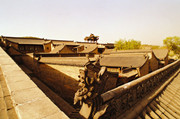Shanxi folk woodcut paintings
( www.chinadaily.com.cn )
Updated: 2012-03-12
Shanxi folk woodcut prints come from Linfen, in the southern part of Shanxi province, and are a popular folk art form, while holding an important place in Chinese history. They are a kind of intermediary between professional art and folk art, and have promoted and enriched the national culture in its development. The artistic images have improved a great deal and the woodcut prints are like an artistic pearl.
Shanxi woodcut prints have a long history, going back to Yang Wei, a famous artist of Jiangzhou during the Song Dynasty (420-479 AD), who was known in the capital city for his paintings of rural lives, which had great market success. In 1127, when Jin Dynasty replaced the Northern Song, engravers who were seized in Bianliang, the capitalof the Northern Song, were taken to Pingyang, which became a center of engraving in northern China. The folk woodcut prints had Linfen and neighboring Guping Shuixian county as a distribution center, and spread to Hongdong, Zhaocheng, Xiangfen, Quwo, and Jishan. Two prints from the Jin Dynasty (1115-1234), “Four Beauties” and “The Brave Wu’an Emperor”, discovered recently in Gansu province, bear the “Pingyang Ji Family Engraving” and “Pingyang Xu Family” seals. From this it can be discerned that these places had a long history of engraving.
The woodcut prints of southern Shanxi are part of the culture of the Yellow River valley and have been influenced by traditional Chinese opera and folk customs through the ages. They have a style of their own that borrows from the bold, unconstrained character of Yellow River culture, the concise, robust features of local opera, and the easy style of mural painting. These can be seen in the treatment of lines, color, design, and subject selection.
They are an exquisite page from the history of Chinese painting for their far-ranging contents, ability to express, heritage, and aesthetic level. Their images provide material for research by cultural scholars on the perspectives of folk customs and traditional Chinese opera. Although more contemporary colors and art has gradually replaced the old woodcut prints used in household decoration, they maintain their place in modern aesthetics. And, the awareness of woodcut prints has been transferred by scholarly vision to contemporary professional artists as nutriment for new artistic visions. They have also become a fundamental part of teaching in new art education.




